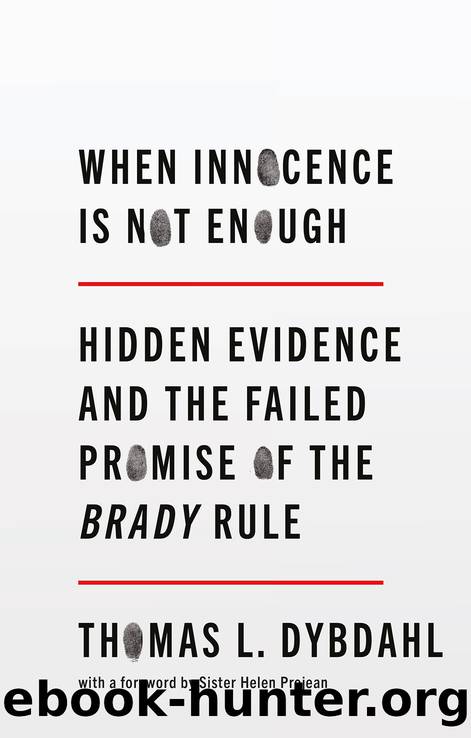When Innocence Is Not Enough by Thomas L. Dybdahl

Author:Thomas L. Dybdahl
Language: eng
Format: epub
Publisher: The New Press
7
AN EPIDEMIC OF VIOLATIONS
Kenneth R. Olsen was an odd duck, as he freely conceded.1 Olsen was a chemist at Agilent Technologies, a manufacturer of analytical laboratory instruments in Liberty Lake, Washington. In August 2001, a coworker using a shared office printer found a document describing explosives.
Company security personnel identified Olsen as the person who had printed the document. When they interviewed him and examined his computer, they found he had made repeated internet searches related to poisons and killing, including such phrases as âundetectable death pill.â He explained that he just had âan irresponsible sense of curiosityâ about âstrange and morbid things.â
The investigators concluded that Olsenâs explanations for these various internet browsings were not credible. He claimed, for example, that he gathered information on poisons to help his sonâs Boy Scout troop avoid potentially dangerous berries.
After the investigation, Olsen was fired. A search of his cubicle disclosed a wealth of printouts on methods of harming people. He also had test tubes, several bottles of medicines, a bag of mysterious beans, and various other chemistry paraphernalia.
Agilent passed these items to the police. A forensic scientist at the Washington State Patrol (WSP) crime lab, Arnold Melnikoff, found that the test tubes contained castor oil. The beans looked like castor beans. This raised the possibility Olsen might have been making ricin, a lethal poison derived from the beans.
Melnikoffâs lab could not test for ricin, so he sent the evidence to the FBI. Twelve items from Olsenâs cubicle proved positive for the poison. They included four capsules of Equate allergy medicine, with one having âa high concentration.â Since the pills had to be liquefied for testing, the lab could not say whether the ricin had been put inside the capsules to disguise it or had been on only the surfaces of the capsules.
In July 2002, Olsen was indicted for knowingly possessing a biological agent or toxin for use as a weapon, based on the allergy pills in his cubicle. A second charge of possession of a chemical weapon was added in April 2003. Three months later, after a twelve-day trial, a jury found him guilty of both charges. His convictions were affirmed on appeal. He was eventually sentenced to ten years and one month in prison.
At his trial, Olsen admitted he made and possessed ricin. But he denied doing it for âuse as a weaponâ or as a âchemical weapon,â which were essential parts of the charges. He said he was just curious.
To prove otherwise, the prosecution offered evidence heâd researched not only how to make poisons but also how to convey them. A key piece of their case was the claim Olsen had spiked an Equate capsule with ricin as a means of delivering it. Melnikoff testified for the government about his handling of Olsenâs items and the tests he had conducted on them.
Six years after Olsenâs convictions, while working on an appeal, his lawyers learned that prosecutors had suppressed evidence regarding Melnikoffâs honesty and professional competence. After getting complaints about him, WSP had conducted an internal probe of Melnikoffâs conduct at two previous jobs.
Download
This site does not store any files on its server. We only index and link to content provided by other sites. Please contact the content providers to delete copyright contents if any and email us, we'll remove relevant links or contents immediately.
The Borden Murders by Sarah Miller(3597)
The Secret Barrister by The Secret Barrister(3016)
Coroner's Journal by Louis Cataldie(2109)
Police Exams Prep 2018-2019 by Kaplan Test Prep(2041)
The Splendid and the Vile by Erik Larson(1794)
Terrorist Cop by Mordecai Dzikansky & ROBERT SLATER(1724)
A Colony in a Nation by Chris Hayes(1514)
My Dark Places by James Ellroy(1511)
Black Klansman by Ron Stallworth(1449)
A Life of Crime by Harry Ognall(1384)
Objection! by Nancy Grace(1338)
Whoever Fights Monsters by Robert K. Ressler(1326)
The New Jim Crow by Michelle Alexander(1321)
American Prison by Shane Bauer(1292)
Obsession (The Volkov Mafia Series Book 1) by S.E Foster(1283)
Anatomy of Injustice by Raymond Bonner(1273)
The Art of Flight by unknow(1268)
A Higher Loyalty by Comey James(1245)
A is for Arsenic: The Poisons of Agatha Christie (Bloomsbury Sigma) by Kathryn Harkup(1217)
